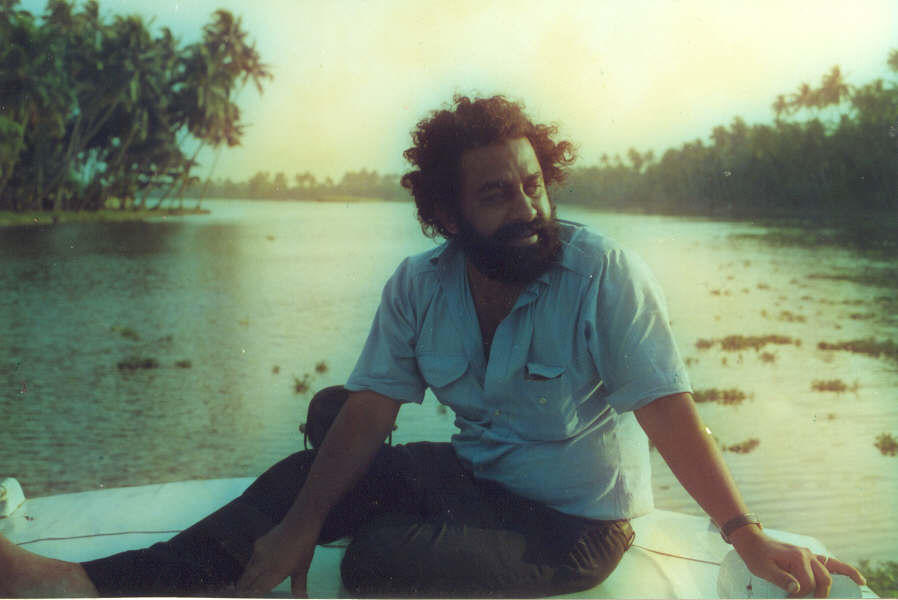
Padmarajan died in a cold January, untimely. He was in a hotel at calicut, in the middle of a celebration of his latest film Njaan Gandharvan (I, the celestial enchanter), in 1991. It was as if audience of the show was subjected to a dismayed silence, and the show was stalled. I for one who had just begun waking upto adolescence and the charm of his creative genius, felt the void, instantly.
Padmarajan started his career as a writer. Unfortunately I have not read any of his books. I know him from his films. If the literary quality of his films is anything to go by, they must be a world to discover. In fact like most of the films, his first film was based on his own novel Peruvazhiyambalam (The grand roadway Inn, 1979). The movie tore down the mythical fence between popular and art house movies. He pioneered the middle of the road solution for commercially succesfull good films and began a short lived golden period of malayalam films alongside Bharathan, Aravindan and M.T. Vasudevan Nair.
The plot of Peruvazhiyambalam was set in a non-descript village somewhere in kerala. It revolved around Raman, an adolescent who inadvertantly killed Prabhakaran Pillai in a scuffle. Pillai, a local bully persecuted him and coveted his sister. After the incident Raman lived in hiding with the help of a truck driver and a prostitute. The movie ended with Raman's realization of his persona as a ravager of Pillai's hapless family. We find the extra-ordinary circumstances in the lives of ordinary people and the choices they made to deal with them.
However the movie was a riot in a deeper sense when Padmarajan ever so subtly slipped in the psychoanalytical threads to metatag the life of Raman in lieu of his insecurities as a teenager, his perceptions of sexuality and growth in a seemingly hostile world. Another aspect of the movie was the use of violence as a leitmotif, which later became an identity of his oeu·vre. He was perhaps the only indian director to deal with psychosis and clinical psychology with some competence. Its interesting to watch him map the animalistic psychological behaviour of his characters to the spatial fields of social consciousness, with an amazing flair for story telling.
Padmarajan is known for his native and localized plots and characters. It is a little unfair on the non-native viewer to pick up on the nuances, but then so was Faulkner's art and so was Ozu's art. I have marvelled at this comparison for sometime. Faulkner's southerner retard Benjy imparted a shock to the readers and similarly viewers were shaken by Padmarajan's blend of anarchist and sexually challenged protagonists.
He made Oridathu Oru Phayalvaan (There lived a wrestler, 1982), a folk parable about the success and failure in the life of a wrestler whose successes in the wrestling arena were starkly contrasted with his sexual impotency. This film portrayed the marginal characters (like the frog catchers) with such brilliance that the movie had an organic existence delineated in a multi dimensional narrative. It provoked an urgent and instant response from the audience. Kallan Pavithran (Pavithran, the thief, 1981) and Arappatta kettiya gramathil (The village with a waist band, 1986) - the story of a bunch of prostitutes and pimps in a village) had the stamp of his magic with precision, warmth and an empathy devoid of prejudice. It was life unclassified.
Like Ozu, Padmarajan was a story teller and relied on the total impact rather than partial brilliance. Philosophically he seemed to share Ozu's social conservatism and perennially interested in the concepts of epic and lyrical times. He even made a movie similar to Ozu's Tokyo Story, Thinkalazcha, Nalla Divasam (Monday, the Good Day).
He went on to make major movies such as Namukku Parkan Munthiri Thoppukal (1986) (Vineyards for us to live), Thoovanathumpikal (1987), Moonnaam Pakkam (The third day) (1988), Aparan (1988), Innale (1989) and finally Njan Gandharvan - 1991 (The Celestial Lover). Each movie followed a different genre in themes, techniques and plots. If the movie, Vineyards to live was an inspired take off on Solomon's song and a beautifull thought on the biblical promise of vineyard for each other by lovers, The Celestial lover was about the phantasmagoric life of a nubile where she found her heavenly lover out of the blue sky, only to be punished by higher powers.
Ironically Padmarajan vanished abruptly, amid life's celebration and at the peak of his almost ethereal creative powers. His films spanned a little over a decade. In the first half he displayed an exceptional ability to bring raw power and subliminal nature of human relationships and the next half lingered more on his liking for variety and experimentation. He endeared most of the viewers like myself with his earlier movies. I was hoping to watch him cover unchartered waters, with the unprecedented support from almost all sections of movie goers. Everything looked perfectly set. But then there was this intervention of death.
The source:
ChroniclesA page on Padmarajan maintained by his family

